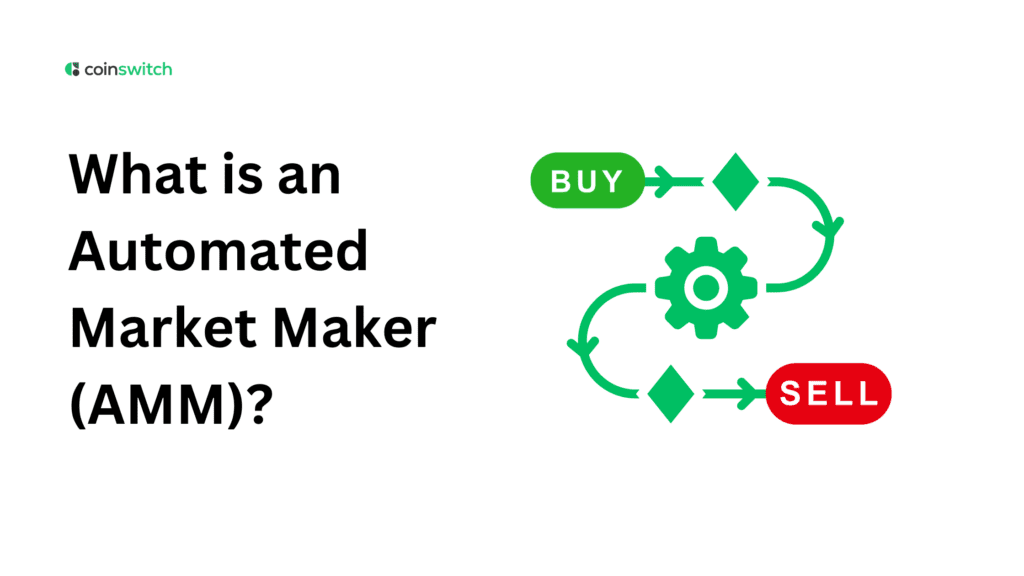When you open a decentralized exchange (DEX) like Uniswap or Curve, you’ll see swapping pairs, price charts, and token pools, but you won’t see a central order book. That’s because DEXs often rely on AMMs, automated market makers, that make trading possible without a traditional intermediary. AMMs are a subset of decentralized exchange (DEX) protocols.
The phrase “market maker” is used to imply a firm that quotes buy and sell prices. With AMM, that concept changes. The “maker” is now smart contracts and algorithms. They automatically price assets, absorb trades, and manage liquidity. No human intervention, no broker order matching.
AMMs power much of modern DeFi. They allow anyone to trade tokens at any time and let anyone supply liquidity to earn fees. If you’ve ever wondered how a token swap happens instantly on-chain, even when no counterparty seems to exist, AMMs are the reason. In this blog post, you’ll understand how AMMs work, why they matter, their benefits and trade-offs, some real examples, where innovation is heading, and what all of this means for traders, builders, and investors.
Understanding Automated Market Makers
At its heart, an automated market maker is a protocol that replaces the order book model with a liquidity pool and an algorithmic pricing formula. In a conventional exchange, buyers and sellers submit orders, and an order matching engine pairs them. But in an AMM, there is no matching engine. Instead, you trade against a pool of funds held in a smart contract.
When you swap token A for token B on a DEX that uses an AMM, you are not waiting for some counterparty to accept your price; you interact with the pool. The protocol ensures trades execute based on the ratio of tokens in the pool and a mathematical rule (often constant product: x*y = k) that determines price shifts. This model means trades always go through (unless insufficient liquidity), and the system is permissionless: anyone can trade, and anyone can contribute liquidity. (Based on general definitions of AMM in DeFi literature)
Liquidity providers (LPs) deposit token pairs into pools. Whenever someone trades, the pool’s balances shift, the price shifts, and LPs collect fees proportional to their share. The algorithm ensures the pool remains balanced and automatically responds to trades.
Because of this, AMMs offer continuous, 24/7 trading without needing human or centralized intermediaries. That is probably the single biggest shift in how markets can work in DeFi versus traditional finance.
How do AMMs Work?
To dig deeper, let’s walk through the internal mechanics of AMMs, using common models and the formula that underpins many of them.
Liquidity Pools & Reserves
An AMM holds two tokens in a pool, say Token X and Token Y. The pool has reserves: the current amount of X (call it x) and Y (call it y). When you swap, you increase one and decrease the other. The algorithm ensures the product (or other invariant) of those reserves stays constant (or follows a defined rule).
The most common model is the constant-product market maker, using the formula:
x * y = k
Here, k is a constant. After a trade, the new reserves must still satisfy this equation (minus fees). If you buy more of X (so increasing y, decreasing x), the price of X in terms of Y rises because you’ve changed the ratio. That’s how price impact works.
Read More: How to Set Up a Crypto Wallet India: A Simple Guide
Price Determination & Slippage
Because trades move the reserves, large trades cause slippage, the difference between the expected price and the executed price. The bigger your trade relative to the pool, the further you move along the curve, and the worse the price. The algorithm doesn’t allow draining the pool; as one token becomes exhausted, the price becomes extreme.
Fees help mitigate this. Many AMMs take a small percentage (e.g, 0.3%) and funnel it to LPs. This helps compensate for LPs who absorb the impermanent loss risk (explained below). The actual formulas for price calculations take fees into account by using the “effective input amount” (after the fee is subtracted) in the equation.
Impermanent Loss & Risk
LPs face impermanent loss, the difference between holding tokens vs. providing liquidity when prices diverge. If token X appreciates significantly relative to Y, an LP ends up with more Y and less X, and sometimes ends with a lower overall value than if they’d simply held both. Arbitrageurs help realign prices, but LPs absorb some of that cost.
Because of these mechanics, many innovations in AMMs try to optimize between trading friction, liquidity efficiency, impermanent loss, and capital usage. For example, Uniswap v3 allows concentrated liquidity, and LPs can allocate to narrow price ranges to improve fee capture but risk being out of range. (Based on enhancements and model shifts in AMM literature)
Variants of AMMs
Beyond the constant product, there are other invariant models:
- Constant sum market maker (x + y = k): Useful for very tight price ranges, e.g. stablecoin swaps. But it is not safe for large price movements because one side can be depleted.
- Stable swap AMMs (like Curve): Pools of stablecoins or similar assets. Designed to reduce slippage between assets that trade at close values. Curve’s model adjusts parameters to minimize price movement for those swaps. (Based on descriptions of Curve’s optimization)
- Weighted AMMs/Constant mean (Balancer): Pools with multiple tokens in custom weights. They generalize the invariant formula to allow many assets.
Each design offers trade-offs: ease of trading, slippage, impermanent loss, and capital efficiency.
Potential Benefits of Using AMMs
AMMs offer several compelling advantages that make them central to DeFi’s growth.
- Permissionless access/On-chain trading at any time
You don’t need to wait for someone else to create a matching order. You can trade immediately by interacting with the pool. No need for listing approvals or centralized gatekeepers.
- Users can provide liquidity and earn fees
Anyone with token pairs can become an LP and earn a share of trading fees. That opens an opportunity for users to turn idle tokens into yield.
- Support for many token pairs
Traditional exchanges list only major pairs. AMMs allow for the creation of any pair, even between niche tokens. This democratizes listing.
- Reduced reliance on centralized intermediaries
Because smart contracts handle pricing, matching, and settlement, trust in centralized parties is minimized. That fits the ethos of DeFi.
- Continuous liquidity
As long as someone adds to the pool, trading can always happen. You’re not stuck waiting for an order to match.
- Composability and integration
AMMs integrate with yield farms, lending protocols, aggregation, and other DeFi building blocks. They become foundational infrastructure.
Of course, these benefits are only meaningful if liquidity is adequate, fees are manageable, and risks are understood.
Recognized AMMs in the Market
To see how theory becomes reality, here are some prominent AMMs shaping DeFi today:
- Uniswap: The pioneer on Ethereum using the constant-product model. It lets people swap tokens directly, and LPs earn fees. It has evolved into v3 with concentrated liquidity.
- Curve Finance: Focused on stablecoins and low-slippage swaps. Because its pools often hold similar-value tokens, price movement is minimal, which reduces risk when swapping stablecoins. (Based on Curve optimizations)
- Balancer: Allows customizable pools with multiple tokens and weights. Rather than equal parts, you might have 80% token A and 20% token B. This flexibility is powerful, but it also adds complexity.
- Sushiswap, PancakeSwap, etc. Many AMMs in various blockchains replicate similar core models but tailor them to network conditions.
These AMMs aren’t just copycats; they push new features. For instance, Uniswap v3 implemented liquidity ranges to let LPs concentrate capital into narrower price ranges and increase fee returns.
Because AMMs are programmable, new versions continue to evolve. Some introduce dynamic fees, others algorithmic rebalancing, or liquidity incentives tied to external metrics or governance. The leading AMMs in the market often outperform traditional exchanges in depth for many pairs. (For example, Uniswap v3 has shown deeper liquidity on specific ETH pairs than major centralized exchanges)
The Future of AMMs
The story of AMMs is still unfolding. Here are trends and potential future directions:
- Concentrated liquidity and custom ranges will refine how LPs allocate capital. We might see more fine-grained control to mitigate impermanent loss and improve fee capture efficiency.
- Hybrid models combining order books + AMM features. Some protocols explore mixing traditional matching with liquidity pools to get the best of both worlds.
- Dynamic fee models. Instead of fixed fees, some AMMs may adjust fees based on volatility, time of day, or pool stress metrics. This would better balance LP incentives vs trader costs.
- Cross-chain/multi-chain AMMs. As interoperability improves, AMMs will span multiple chains, enabling seamless swaps across ecosystems.
- Better risk mitigation strategies. New designs, such as improved invariant functions or dynamic rebalancing to reduce impermanent loss, are under research and development. (Research on algorithms to reduce loss exists.)
- Institutional adoption. As AMMs mature, institutions may use them for their trading strategies, liquidity provision, or algorithmic execution.
In time, AMMs may not just be niche DeFi tools; they could influence how modern financial markets operate, blending algorithmic liquidity with trading models we see today.
Conclusion
An AMM, or automated market maker, reimagines the “market maker” role. Instead of a person quoting prices, you’re interacting with liquidity pools and smart contracts. The algorithm sets the price, and trades execute automatically.
AMMs offer accessibility, constant liquidity, yield potential for LPs, and permissionless listing of tokens. But they also carry risks, impermanent loss, slippage, and liquidity constraints. Recognized AMMs, such as Uniswap, Curve, and PancakeSwap, demonstrate how diverse designs can cater to various use cases.
Looking forward, AMMs will continue to evolve: hybrid models, intelligent fees, cross-chain setups, and risk innovations. For traders, builders, and crypto enthusiasts, the rise of AMMs is one of the most powerful stories in DeFi.
So next time you swap a token on a DEX without seeing a counterparty, remember: behind that ease is math, code, and ingenuity, an AMM doing the heavy lifting.
FAQs
1. What is the best AMM crypto?
Uniswap dominates the AMM space. It runs on Ethereum, supports massive trading volumes, and offers deep liquidity across tokens.
2. How to create an AMM?
Developers start by writing a smart contract using a formula like x*y=k. It needs funding with crypto pairs and must run on a blockchain that supports smart contracts, like Ethereum or Solana.
3. What do you mean by AMM?
AMM stands for Automated Market Maker. It’s a smart contract system that replaces traditional order books with liquidity pools to enable instant token swaps.
4. Who uses AMM?
Crypto traders, yield farmers, and DeFi protocols rely on AMMs to trade tokens, earn fees, and provide liquidity without centralized intermediaries.








